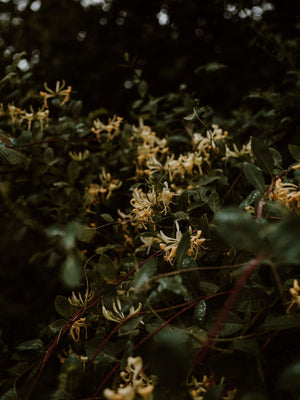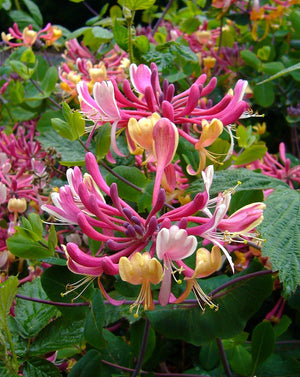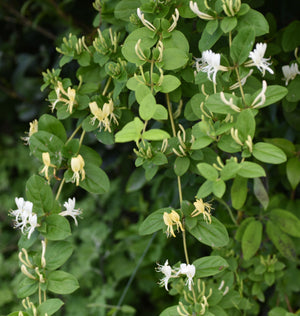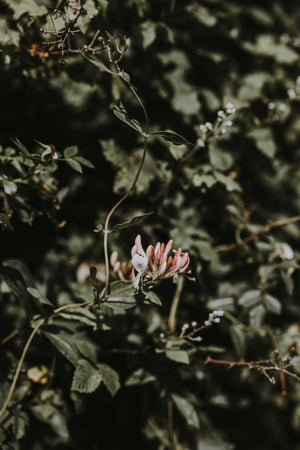The Honeysuckle Guide
In the realm of ornamental vines, honeysuckle stands as a symbol of timeless beauty and aromatic allure. With its graceful tendrils, vibrant blossoms, and sweet-scented nectar, honeysuckle weaves a tapestry of charm that enhances any landscape. This versatile and enchanting plant offers not only visual delight but also beckons with the intoxicating fragrance that lingers in the air. Whether adorning fences, climbing trellises, or cascading over arbors, honeysuckle brings a touch of magic to gardens and outdoor spaces, making it a captivating choice for both seasoned gardeners and newcomers alike. Join us on a journey through the intricacies of planting, caring for, and enjoying the splendor of honeysuckle, a timeless addition that elevates the beauty of your outdoor haven.

About
In the enchanting world of climbing vines, honeysuckle (Lonicera spp.) emerges as a captivating genus within the family Caprifoliaceae, adorning landscapes with its diverse array of deciduous and evergreen shrubs. Represented by numerous recognized species, honeysuckle brings forth a floral tapestry that spans temperate and subtropical regions, creating a sensory symphony in gardens. These graceful vines are characterized by their elegantly entwining branches, adorned with clusters of small, fragrant flowers that range from delicate white and pink to vibrant lavender, evolving through the seasons. Beyond the visual spectacle, honeysuckle is a vital player in supporting local ecosystems. Its nectar-rich flowers act as a magnet for essential pollinators like bees, butterflies, and hummingbirds, contributing to the overall biodiversity of the garden. The dense foliage and intricate branching structure provide shelter for small birds and insects, establishing honeysuckle as a cornerstone in fostering a harmonious natural environment.
Honeysuckle exhibits remarkable adaptability to various soil types and environmental conditions, showcasing its versatility in different garden settings. While it thrives in moist, well-drained soil, it gracefully tolerates both full sun and partial shade, making it suitable for a myriad of landscaping applications. Its moderate growth rate and manageable size further enhance its appeal, whether employed as a standalone feature, part of a vibrant hedge, or integrated into mixed borders. Popular species within the honeysuckle genus include the Japanese honeysuckle (Lonicera japonica) and the Coral honeysuckle (Lonicera sempervirens), each contributing distinct characteristics to this botanical ensemble.
By selecting and caring for honeysuckle in your outdoor space, you not only elevate its aesthetic allure but actively participate in the preservation of a remarkable plant that harmonizes with the rhythms of nature. Embrace the diversity and resilience of honeysuckle, and let its fragrant blooms weave a tale of elegance and beauty in your garden, ensuring a perennial haven for both you and the vibrant life it attracts.

Planting
Honeysuckle, with its enchanting vines and fragrant blooms, requires thoughtful consideration during the planting process to ensure its thriving establishment and flourishing growth. Here are indispensable guidelines for planting and caring for honeysuckle:
Soil: Honeysuckle thrives in well-draining soil enriched with organic matter. It favors a slightly acidic to neutral soil with a pH between 6.0 and 7.0. Prepare the planting site by loosening the soil and incorporating ample compost or organic matter. This not only enhances drainage but also fosters fertility, providing a nutrient-rich foundation for the honeysuckle to flourish.
Sunlight: Honeysuckle plants prefer basking in the full sun, although they exhibit adaptability to partial shade. When selecting a planting location, prioritize areas that receive at least six hours of direct sunlight daily. In regions with hot and dry climates, honeysuckle can tolerate partial shade, showcasing its versatility in various environmental conditions.
Watering: Adequate and consistent watering is paramount, especially during the initial stages of honeysuckle establishment. Deeply water the plant immediately after planting and maintain regular irrigation throughout the first year. Adjust the watering frequency, aiming for deep and thorough watering once or twice a week, depending on rainfall and soil moisture levels. Be cautious to avoid overwatering, as excess moisture can lead to root rot.
Mulching: Applying a layer of organic mulch around the base of the honeysuckle provides numerous benefits. Mulch helps conserve soil moisture, suppresses weed growth, and regulates soil temperature. Use materials like wood chips, bark, or compost as mulch. Ensure a gap of a few inches between the mulch and the plant's base to prevent excess moisture accumulation.
Pruning: Honeysuckle typically requires minimal pruning to maintain a robust and balanced structure. Focus on removing dead, damaged, or crossing branches. The optimal time for pruning is during late winter or early spring when the plant is dormant, just before new growth emerges. This minimizes stress on the honeysuckle and encourages healthy development.
By adhering to these fundamental planting and care guidelines, you pave the way for the successful establishment and vigorous growth of your honeysuckle. These practices contribute not only to the plant's longevity but also to the beauty it brings to your outdoor space, creating a haven for years to come.

Care
Honeysuckle, with its captivating beauty, demands specific care practices to ensure optimal growth and enduring vitality. Here are comprehensive guidelines to grace your garden with the enduring beauty of honeysuckle:
Watering: Provide moderate and consistent watering during the growing season. Aim for approximately one inch of water per week, adjusting based on natural rainfall. Deep and thorough watering is crucial to encourage robust root development. Avoid shallow watering, as it may induce stress and dehydration. In periods of drought or elevated temperatures, additional watering may be necessary to maintain adequate soil moisture.
Pruning: While honeysuckle generally requires minimal pruning, selective care enhances overall health and aesthetic appeal. Remove any dead or damaged branches to preserve vitality and appearance. Shaping can be employed to achieve the desired size and form. The optimal time for pruning is during late winter or early spring, before the onset of new growth. Use clean, sharp pruning tools to minimize the risk of harm to the plant. Deadheading spent flowers can stimulate new growth and potentially trigger a second blooming, contributing to a prolonged flowering season.
Fertilizing: Fertilization plays a pivotal role in promoting vibrant growth and abundant flowering in honeysuckle. Apply a balanced, slow-release fertilizer in the spring or early summer, following the recommended application rates and timing specified by the manufacturer. Exercise caution to avoid over-fertilizing, as it can negatively impact the plant's root system. When uncertain, opt for a conservative approach and use less fertilizer, ensuring the health and longevity of your honeysuckle.
Soil and Sunlight: Honeysuckle thrives in well-drained, moist soil and revels in full exposure to sunlight. While it exhibits tolerance to diverse soil types, ensuring optimal drainage is essential for its well-being. Mulching around the base of the plant contributes to moisture retention and regulates soil temperature, creating a conducive environment for healthy growth.
Pests and Diseases: Though generally resilient, honeysuckle can face challenges from pests like aphids, birch borers, and leaf miners. Vigilance is key—monitor your plants for signs of damage or disease. Swift action with appropriate insecticides or fungicides, when necessary, will help safeguard the health and vitality of your honeysuckle.
By adhering to these holistic care guidelines, your honeysuckle will flourish, becoming a perennial source of beauty, fragrance, and majesty in your garden for many years to come.

How To Use
Honeysuckle, with its versatile and captivating nature, offers a myriad of possibilities to enhance your landscape. Tailor its characteristics to your advantage with these insightful recommendations:
Arboreal Elegance: Create a captivating focal point in your garden by showcasing honeysuckle as an arboreal masterpiece. Plant a cluster of these climbers in an open area, allowing them to ascend trellises or arbors, transforming your outdoor space with their twining vines and enchanting fragrance. This vertical showcase can serve as a visually striking centerpiece.
Natural Edges: Define the natural contours of your garden beds with the grace of honeysuckle. Their climbing habit makes them perfect for creating natural borders that seamlessly blend with the landscape. Allow them to weave a living tapestry of color and texture along pathways or around garden features, adding a touch of wild elegance to your outdoor sanctuary.
Living Screens: Turn ordinary features into extraordinary elements by employing honeysuckle as living screens. Their vigorous growth habit provides not only a verdant privacy shield but also a burst of color and fragrance. Regular pruning can maintain a neat appearance, and these vibrant screens can redefine the aesthetics of your garden, creating secluded retreats or hiding unsightly views.
Potted Panache: Embark on creative container gardening adventures by cultivating honeysuckle in pots or containers. This allows you to bring these delightful climbers to different areas, adding bursts of color, fragrance, and vertical interest to patios, decks, or balconies. Experiment with various container sizes and shapes to customize your outdoor space with portable allure.
Companion Planting: Elevate your garden's visual appeal and ecological balance by integrating honeysuckle as a companion plant. Their vibrant foliage and flowers complement a variety of other plants. Combine honeysuckle with perennials, shrubs, or trees in mixed borders to create visually pleasing and ecologically supportive plant communities. Ensure compatibility by avoiding plants that may be overwhelmed or hindered by honeysuckle's vigorous growth.
Whether you're seeking a vertical focal point, a natural border, a living screen, or a potted masterpiece, honeysuckle brings versatility and natural charm to your landscape. Consider its climbing habit, fragrant blooms, and adaptability when planning your garden. With honeysuckle, you're not just gardening; you're crafting a living masterpiece that evolves with the seasons, adding a touch of nature's sophistication to your outdoor haven.
Conclusion
In the realm of landscaping, honeysuckle emerges as a dynamic and enchanting climber, orchestrating a symphony of colors, fragrances, and versatile uses for your outdoor haven. With its graceful vines and adaptability, honeysuckle adds a touch of natural allure to diverse garden settings. As you compose the story of your garden, honeysuckle weaves its narrative through cascading blooms, from the delicate whites and pinks of spring to the vibrant hues of summer and the warm, rustic tones of fall, painting a living canvas that evolves harmoniously with the seasons.
Beyond its visual appeal, honeysuckle fulfills multiple roles in your outdoor sanctuary. Whether employed as a climbing focal point, a natural border, a fragrant living screen, or a potted masterpiece, these climbers seamlessly blend aesthetics with practicality. Crafting privacy, defining spaces, and enhancing the charm of your garden, honeysuckle proves that beauty can indeed be functional.
A testament to its versatility, honeysuckle thrives as a companion to various plants, adding a layer of complexity to mixed borders or perennial groupings. With honeysuckle as a key player in your garden ensemble, you're not merely cultivating climbers; you're nurturing a harmonious ecosystem, inviting birds, butterflies, and beneficial insects into your outdoor realm.
Embrace the ever-changing melody of your garden with honeysuckle as a central note. Its resilience and ability to adapt ensure that your landscape remains dynamic, responding rhythmically to the seasons. By incorporating honeysuckle, you're not just creating a garden; you're designing an outdoor space that resonates with life, color, and the subtle charm of nature's symphony.
In the realm of garden design, honeysuckle transcends being merely a climber; it becomes a living refrain, adding depth and beauty to the melody of your landscape. With thoughtful planting, care, and creative deployment, honeysuckle becomes the crescendo that elevates your outdoor space to a masterpiece. Nurture your garden with the dedication it deserves, and let honeysuckle be the timeless refrain that brings you joy, fragrance, and natural elegance for years to come.
